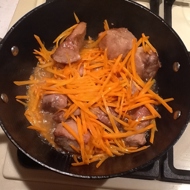
Eastern Pilaf in Urban Conditions
⏳ Time
1 hour 45 minutes
🥕 Ingredients
6
🍽️ Servings
6
Description
Those who have traveled through the Uzbek expanses know that in every region and in different families, the recipe is unique. Only a few basic rules remain the same, but there can be significant differences in nuances, spices, and sometimes even in the main ingredients. Every dish inevitably carries the distinctive features of the cook. Therefore, when ordering Pilaf in different cities and establishments, you will be tasting quite different rice and meat dishes under the same name. This recipe is a sort of author's generalization of various approaches to preparing pilaf, made by the author during a twenty-year interest in this dish, adjusted for living in a large city. At the market, we buy 700–800 grams of pork. If it has some fat, that's even better. We stock up on two or three medium-sized carrots, a couple of heads of onion and garlic. Almost all markets have sections where representatives of the southern regions of the former USSR offer spices. We approach and order a set of seasonings for pilaf. The only thing to clarify is the spiciness. I always ask for a medium-spicy blend and to add more cumin, but it depends on personal preference. The cumin should be green (there is also black). Cumin can also be purchased separately. And don't forget to buy chickpeas here as well — we will need half a cup.
Ingredients
- Pork Blood - 28.2 oz
- Parboiled and wild rice blend - 28.2 oz
- Carrot - 10.6 oz
- Spices - to taste
- Onion - 10.6 oz
- Chickpea - ½ cup
Step by Step guide
Step 1
Prepare a cast-iron cauldron (or at least a Dutch oven) with a capacity of 4–5 liters.
Step 10
Cover with a lid and do not lift it for 15–20 minutes. This is where the magic begins: you need to cook the rice almost to readiness but not overcook it. This is achieved by balancing the amount of water, rice, and the heat level on the stove. After a few attempts, you will definitely succeed.
Step 11
After 20 minutes, open the lid. The rice has absorbed the water. Now, with gentle, smooth movements (trying not to mix), shift the rice with a wooden spoon from the edges to the center to form a mound. In this mound, make several holes with the handle of the spoon for the excess water to evaporate inside the dish. Leave it on low heat under the lid for another 5–10 minutes. Now you can finely chop the herbs (parsley, dill, green onion, and optionally — cilantro).
Step 12
Turn off the heat and let the pilaf sit under the lid for about 10 minutes.
Step 13
Before serving, open the lid and gently mix the contents of the cauldron (bottom to top, bottom to top). Serve on plates, topped with a pinch of herbs, but not too much.
Step 2
Preparation: rinse the pork, place it on a cutting board. Separate the fat layer and cut the fat into small cubes. Place the cauldron on the stove (over high heat) and add the cubes of fat. Let it render for about 10 minutes (traditionally, lamb fat is used, but it's hard to find in my city, as well as fresh lamb).
Step 3
Cut the meat into large cubes. Peel the onion and carrot. Cut the carrot into strips (with a knife, without using any fancy graters) about 4–5 cm long, and slice the onion into half-rings.
Step 4
When the fat in the cauldron has rendered and turned into dark cracklings, remove them with a slotted spoon and discard. You can leave them for those who enjoy cracklings.
Step 5
Add the meat to the hot fat and fry it. As soon as a crust forms, add the carrot (the strips should sizzle actively upon immersion), and after 5–7 minutes, add the onion. Do not reduce the heat or cover with a lid. If there is not enough rendered fat, add a little vegetable oil. And salt to taste.
Step 6
When the onion darkens, add the chickpeas (from ¼ to ⅓ cup – depending on preference), add one cup of water, reduce the heat to medium, and cover with a lid. Simmer for about 20 minutes. Boil 1.5 liters of water.
Step 7
Rinse 700–800 grams of rice thoroughly (6–7 times) until the water runs clear. For the last rinse, pour boiling water over it and let it sit for a couple of minutes. Then drain the water.
Step 8
Sprinkle the spice mixture (usually 2–3 pinches) that we bought at the market over the top of the rice in the cauldron. If the mixture lacks cumin, you can add a pinch or two separately.
Step 9
An important step: reduce the heat to the minimum and add the rice. With a tablespoon (or wooden spoon), lay the rinsed and scalded rice on top of the meat without mixing. In this rice, 'hide' the rinsed and unpeeled garlic — one or two heads. Pour boiling water over the rice (gently, using a spoon). The water should cover the rice by 1.5–2 cm. On top, sprinkle a pinch of barberry — it will give an unforgettable tang. If necessary, add salt.
Cooked This Dish? Share Your Delicious Creation with the Community! 🥰
Snap a photo and let everyone see your culinary masterpiece. Inspire others and showcase your skills!
Users Photos
No photos yet
Leave a Comment
Please log in to leave a comment.